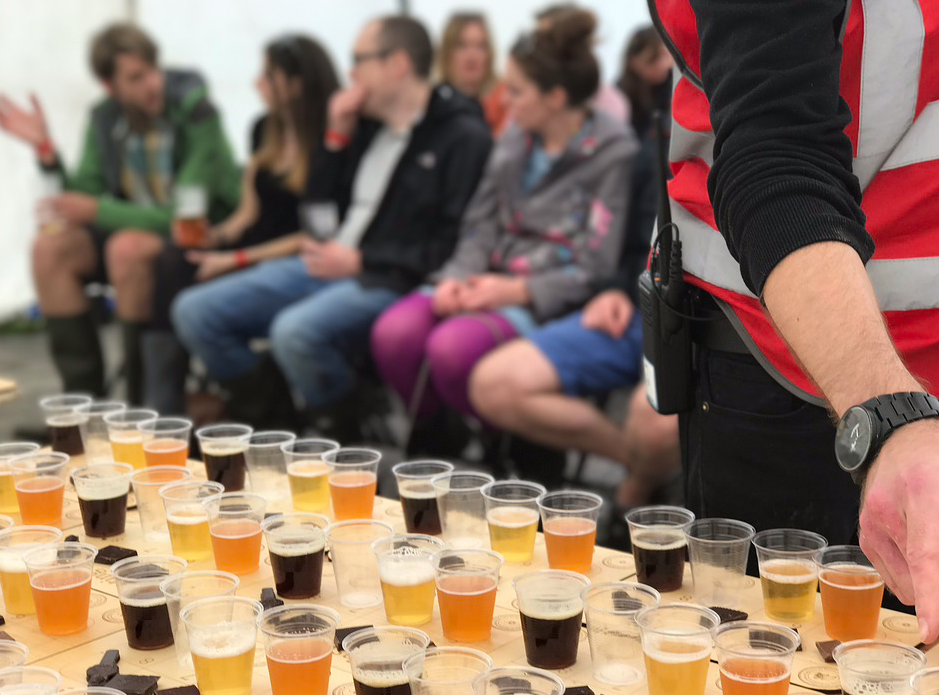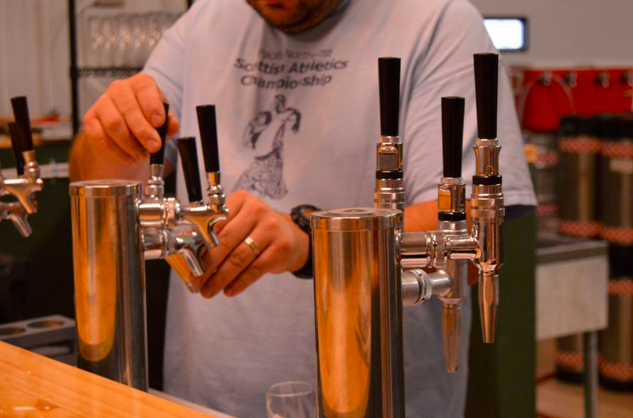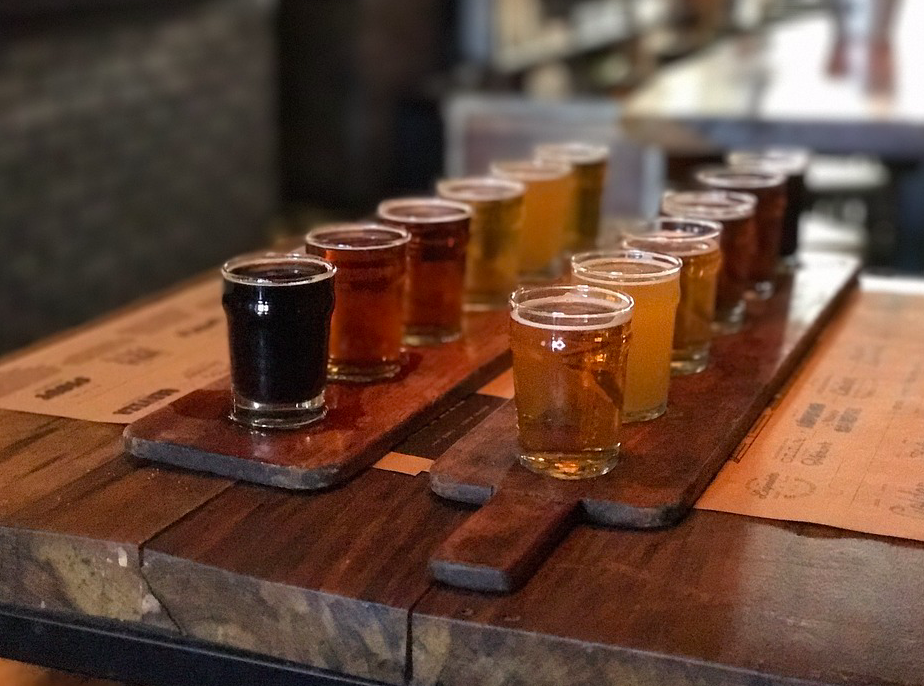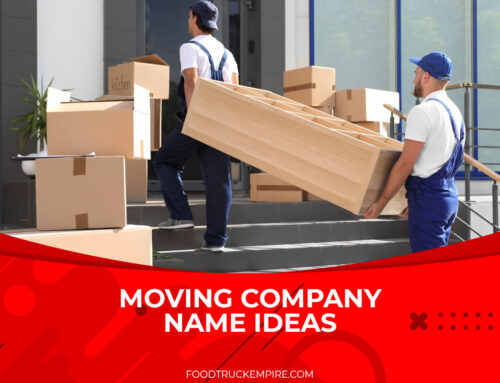There are more than 6,200 craft breweries (including brewpubs and microbreweries) actively operating in the United States according to industry reports. But have we reached peak consumption trends in this industry? Is it too late to start your own?
We attempt to answer these questions based on our in-depth industry research and predict the future trends of this important industry with an estimated economic impact of over $246 billion annually. We also share some of the pivots these craft breweries are beginning to experiment with to stay relevant to changing consumer taste. So pour yourself a lager or maybe an IPA and let’s examine these industry statistics.
Global Craft Beer Industry Statistics

A wall of craft beer options to try.
In 2018, there were around 7,346 operating brewers in the U.S. alone. (Craftbeer.com)
Millennials aged 18 to 30, are at the core of the craft beer consumption. The age group felt deeply about their beverage – what it does to their health or the planet and where it came from. (DSM)
Gen X and Gen Y, which are known as traditional beer drinkers, have also grown interested in craft beer fueling its popularity among the age group. (Fact.MR)
Approximately 26 million barrels were produced in 2018, while the number of operating brewers zoomed past 7,000 the same year. (Statista)
There were an estimated 150,000 micro-brewing jobs in 2018. (Craftbeer)
Local, as well as international brewers’ venture into network expansion with new and exciting flavors, have brought in higher earnings for craft beer in comparison with traditional beer. (MarketWatch)
Audio Lesson: How I Started a Craft Brewery for $50,000
The Brewers Association (BA) changed the category of “small” brewers to companies producing fewer than 6 million barrels, this after the largest craft beer producing company breached the 2 million barrel threshold. (Forbes)
Craft beer retail sales in 2018 amounted to $27.6 billion, a 7% jump from the previous years and now comprises 24% of the $114.2 Billion U.S. Beer market. (Brewersassociation.org)
According to a study made by Beer Marketers’, some of the major beer brands are on a decline as a distribution from the top 10 beer brands only accounted for 53% of the market last year as supposed to 62% back in 2008. (Bizjournals.com)
Despite craft beer contributing to the decline of these major brands from 2010 to 2015, craft beer growth itself has recently slowed down. (Bizjournals)
According to a report from Hop Growers of America, there are now 29 states involved in hop production. (Science Daily)
Consumers with higher incomes generally purchase craft beer, this is because craft beer is generally pricey than regular lager beers. (Allied Market Research)
In a survey of millennials aged 18 to 30, revealed that the beer they drink says a lot about their personality. According to them, the purpose, story, and motivations of the company behind their choice of beer are what matters. (DSM)
Trading using wholesalers, retailers, and online channels, off-trade circulation is a non-traditional distribution channel typically used by craft beer brewers to market their products. (Market Study Report)
Among half of the under-30-year-olds who were evaluated, increased their craft beer consumption compared to 2 years ago. They validated that beer quality is also important in choosing their favored craft beer. (DSM)
The U.S. Craft Beer Industry

A light and dark beer flight.
Massachusetts has seen multiple brewery openings for eight straight years and shows no traces of backing down in 2020. (Mass. Brew Bros.)
In the overall U.S. beer industry, the craft beer revolution carries on as the craft beer industry share achieved a total of 13.2% (Statista)
Soon to exceed 8,000 in total, American breweries have already reached a significant number in the past few years. (BeverageDynamics)
The U.S. now has the most number of beer brands and flavors to choose from than any other nation in the world. This is the result of the current number of breweries in the country today. (Craftbeer)
There is insider speculation that Massachusetts breweries are reaching a saturation point. Despite this, there is still a significant number of breweries that are expected to open in the state. (Mass. Brew Bros.)
Vermont is considered as the craft beer capital of America. This is because Vermont has 11.5 breweries per capita, generating 151.2 pints for each adult aged 21+ (C + R Research)
Tied in 2nd place are Montana and Maine, both of which have 9.6 breweries per capita. They are followed by Oregon with 8.5 and Colorado with 8.4 breweries per capita to complete the top 5 craft beer states. (C + R Research)
The Brewers Association reported that U.S. craft beer grew from below 5% to about 13% market share of beer sales in America in the 2010s. (Forbes)
In 2018, there were 231 regional breweries, 4,521 microbreweries, and 2,594 brewpubs spread around the country. (Statista)

According to Mass. Brew Bros., there are about 49 known new breweries to open in the area this year. Twenty four of these breweries are new, while the remaining twenty-five are existing breweries either expanding through supplementary locations or contract brands constructing brick and mortar breweries. (Mass. Brew Bros)
U.S. hop farms grew in number from 68 to 817, while land occupied hops increased from 31,145 to 59,429 acres. (Science Daily)
There is no state without a single craft beer brewery. The state with the smallest number of craft brewery per capita is Mississippi, coming in at No. 50 with 0.6 craft beer brewery per capita. (C + R Research)
Though U.S. beer volume revenues generally declined by 1% in 2018, craft beer volume sales grew at a rate of 4%. The craft beer market achieved a 13.2% share of the overall U.S. beer market. (Brewersassociation.org)
Last year, the Brewers Association anticipated the craft beer figures rose 4%, approximately one million barrels according to industry publisher Brewbound. Furthermore, U.S. craft beer gains have diminished given that volumes have also increased by single-digits only. (Forbes)
Beer Marketers’ Insights’ Christopher Shepard approximated that the U.S. craft beer generated 27.15 million barrels last year, which was up 4% though this was distributed among 8,000 breweries. (Bizjournals.com)
Breweries in the United States more than quadrupled from 992 to 4,000 in 10 years (2007-2010), according to data from the U.S. Census of Agriculture and ReferenceUSA. (Science Daily)
Craft beer retail sales were up $26 Billion, an increase of 8%, now amounts to over 23% share of the $111.4 billion total U.S. beer market. (Intechopen)
Global Craft Beer Market

Craft beer consumption has become a global phenomenon.
Thanks to the use of leading-edge brewing methods and the use of premium ingredients, a great number of beer drinkers are known to have shifted from traditional to craft beer. (Market Study Report)
In 2019, The global craft beer market was valued at $ 76,310.7 Million. (Fact.MR)
In terms of craft beer production volume and value Belgium, New Zealand, Australia, Germany, and the U.S. remain at the top of the pack. (Goldstein Research)
On average, the countries mentioned above hold 65% of the total global craft beer market share. (Goldstein Research)
In the global market, craft beer is segment by-product: pale ale-based craft beer, IPA-based craft beer, lager-based craft beer, seasonal-based craft beer, amber ale-based craft beer, and others. (TechNavio)
The total number of U.K. craft beer breweries is estimated to have reached 2,274 in 2018. (The Conversation)
Despite starting its revolution in the U.S., Europe leads the global craft beer market and is anticipated to reign supreme in the period 2018 to 2025. (Allied Market Research)
Craft beer growth in the emerging markets such as Vietnam and China is in its early phase, while the U.S. craft beer is currently at a decline in its core market. (Euromonitor)
The U.K. holds the 2nd biggest number of breweries per person, only trailing New Zealand as of 2019. (The Conversation)
Craft beer consumption in India increased at a rate of 20% per year, as to when the craft beer trend started in 2010. (Fact.MR)
Back in 2018, the craft beer global market size was estimated at $108,912 million and is likely to hit $186,590 million in the year 2025. A growth rate of 8% per annum from 2018 to 2025. (Allied Market Research)
Canada, Australia, New Zealand, Scandinavia, Japan, and some parts of Europe are spearheading the growth of craft beer by offering conventional Euro-style lagers. (MarketWatch)
In the U.K., there are early signs of craft beer growth stagnation as the opening of new breweries has already peaked. Data from the UK’s Office for National Statistics revealed that U.K. overall beer sales have declined from £3.7 billion to £3.2 billion in 2018-2017 respectively. (The Conversation)
The U.S. and Europe account for the most number of breweries around the world, with over 10,000 breweries spread across the two territories. (Goldstein Research)
Some of the major players in the European craft beer market include and not in any particular order: Buxton Brewery Co. Ltd., Asahi Group Holdings Ltd., Duvel Moortgat NV, Beavertown Brewery, The Boston Beer Co. Inc., BrewDog Plc, Thornbridge Brewery, Mikkeller ApS, and Stone Brewing Co. (TechNavio)
On-trade distribution channels showed increased potential due to the rise of the hospitality sector in developed economies. Meanwhile, off-trade distribution also showed great opportunities in emerging markets where affordability is key to sales performance. (Market Study Report)
Acquisitions and mergers suggest that the number of major brewers has shrunk, total production shows otherwise, as it maintained a steady volume over the years. (Intechopen)
Craft Beer Market Consumption Trends

There’s nothing like the smell of fresh hops in the morning.
During the forecast period of 2020 through 2025, the global craft beer market is expected to rise with a CAGR of 14.1% (Mordor Intelligence)
Currently, the craft beer market share with the overall U.S. beer market stood at 12%. This figure has plateaued in the past few years since craft beer sales have remained at single-digit growth. (BeverageDynamics)
As competition intensifies, many microbrewers are branching out into Kombucha, alcoholic seltzers and even spirits. (Euromonitor.com)
The European craft beer market is projected to rise by 1,324.31 million liters from 2020 to 2024. It is also expected that the growth surge would increase within the forecast period. (TechNavio)
Since retail shelves are crowded with a variety of brands, new brewers prefer to pass on distribution and instead go for taproom sales. Though most of their income happens on-site, some brewers still consider distributing locally. (BeverageDynamics)
Related Reading: 57 Stunning Tea Consumption Statistics and Trends
With the BA reporting slow growth in the craft beer market, the industry seems to be headed into a division. On one end are the microbrewers who distribute locally while on the other end are the major craft brewers like Boston Beer Company with national and regional distribution channels. (Euromonitor.com)
The thriving craft beer trend among Asian consumers is anticipated to drive industry growth. Other alcoholic drinks such as wine have somewhat become a hazard in the growth of the craft beer industry in Asia. (Mordor Intelligence)
Boosting the popularity of craft beer in some parts of the world can be attributed to consumer’s preference for new flavors and styles. (MarketWatch)
Low-alcoholic beverages are on the rise with increasing demand from health-conscious drinkers. Driving the market is a wide variety of these low alcoholic beverages offered by key craft beer brewers with better taste and low alcoholic content containing 2.8% ABV or less. (Mordor Intelligence)
Global craft beer numbers are surging despite the macro brewer’s supremacy in the market. (Intechopen)
What Does the Future Look Like?
Over the years, brewers served traditional beers as a way of creating product loyalty among its consumers. Thanks to a new generation of brewers and drinkers, craft beer was born. Formerly known as “boutique ” beer made by microbrewers, craft beer began its roots in America around 30 years ago.
Though statistics reveal that craft beer growth has plateaued in its chief markets like the U.S., most of the data still show craft beer exhibit potential growth in the emerging economies of the APAC region.
This can also be observed in the surveys conducted that craft beer remains popular among millennials, particularly between the ages of 18 and 30. The creativity that comes from making the beer is an important factor why they patronize the beer of their choice.
In saturated markets such as the U.S., competition is considerably compelling for some microbrewers to turn their creative output into alcoholic seltzers, Kombucha, hard ciders, and other spirits.
This shows that when a product hits a certain threshold of popularity, it will branch out and evolve. We’ve seen this happen already with all the different types of IPA’s now available (West Coast Style, Double IPA, Session IPA). We are also expect increased in gluten-free beers.
Even though many craft beer brands are competing for shelf space, we expect the craft beer industry will continue taking market share for the next five years.




